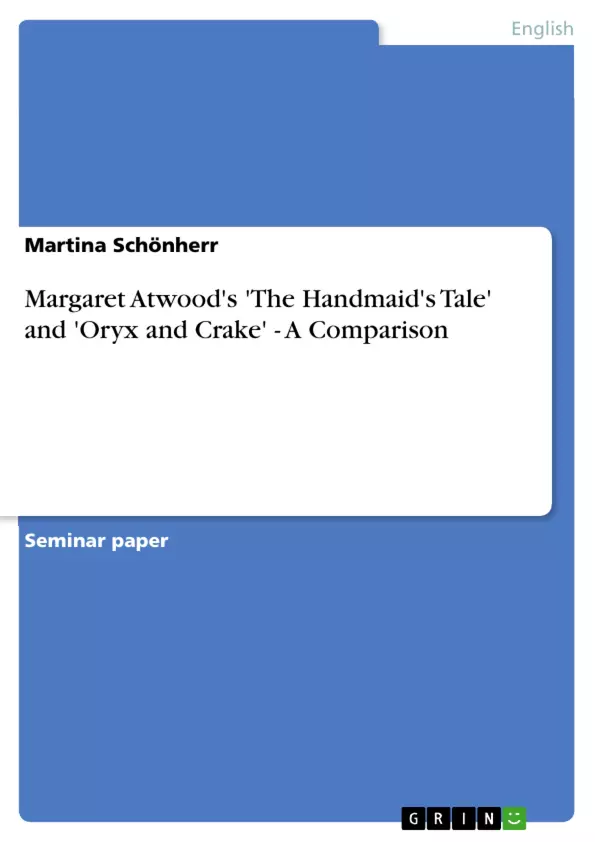Margaret Atwood’s novels The Handmaid’s Tale (T.H.T., 1985) and Oryx and Crake (O. & C., 2003) are works of speculative fiction that are set in the near future. Both of the depicted scenarios take place in the U.S.A. and could be classified as “survivor’s stories” as they are told from the perspective of a person that survived the new system or the catastrophe the books deal with.
T.H.T. takes the reader into an oppressive system that has become reality in the year 2005. In this system women are divided into different kinds of “functional groups” according to their abilities. The story is told by the handmaid Offred who – as all handmaids – is still believed to be fertile. Thus she is solely good for childbearing and has not got any choice. This system however is confined to the United States so that there is still hope for an escape to a better life for the people living under the system. The scenario in O. & C. on the other hand occurs around the year 2025 and depicts a world wide catastrophe where Snowman – the narrator of the story – is one of the few surviving human beings.
This paper will compare the two novels according to some points of analysis. I had to confine myself to a few themes as it is impossible to include all topics that could be of importance.
To start with, I will take a look at the social and political background of the time the novels were written in, followed by a generic analysis of the works. Secondly I will answer the question about the inspiration for these novels and I will deal with the epilogues Atwood added to her books. This will be followed by a chapter about the main topics of the novels which are reproduction, religion and sexuality. Last but not least I will compare the main characters and discuss the message of her works.
Inhaltsverzeichnis (Table of Contents)
- Introduction
- The Handmaid's Tale and Oryx And Crake: A Comparison
- Social and political Background
- Genre, Inspirations for Writing the Novels
- Epilogues
- Reproduction, Religion and Sexuality
- Comparison of the main Characters
- Message of the Novels
- Conclusion
- Bibliography
Zielsetzung und Themenschwerpunkte (Objectives and Key Themes)
This paper compares Margaret Atwood's novels The Handmaid's Tale and Oryx and Crake. The goal is to highlight how these novels, written in different times, reflect contemporary social, political, and environmental issues through the lens of speculative fiction. The paper explores the social and political backgrounds of the novels, analyzes their genres and inspirations, and examines key themes like reproduction, religion, and sexuality. Additionally, the paper compares the main characters and discusses the message of each work.
- Social and political contexts of the novels
- Genre and inspiration for writing
- Themes of reproduction, religion, and sexuality
- Comparison of main characters
- Message of the novels
Zusammenfassung der Kapitel (Chapter Summaries)
The introduction sets the stage for the comparative analysis of Atwood's The Handmaid's Tale and Oryx and Crake, highlighting their shared themes of survival and dystopian futures. Chapter 2.1 explores the social and political contexts of the novels, connecting their narratives to the anxieties and concerns of the 1980s and early 2000s respectively. Chapter 2.2 delves into the genre and inspiration behind the novels, emphasizing Atwood's use of speculative fiction to explore real-world issues. This chapter also discusses Atwood's distinction between science fiction and speculative fiction. Chapters 2.4 and 2.5 delve into key themes within the novels, including the intertwining of reproduction, religion, and sexuality, and the development of the main characters.
Schlüsselwörter (Keywords)
The primary keywords and focus topics of this analysis are speculative fiction, dystopian futures, social and political commentary, reproduction, religion, sexuality, and character comparison. The analysis focuses on Atwood's use of speculative fiction to explore contemporary anxieties, particularly regarding the future of humanity, the role of women, and the implications of technological advancement.
- Arbeit zitieren
- Martina Schönherr (Autor:in), 2007, Margaret Atwood's 'The Handmaid's Tale' and 'Oryx and Crake' - A Comparison, München, GRIN Verlag, https://www.grin.com/document/134143



